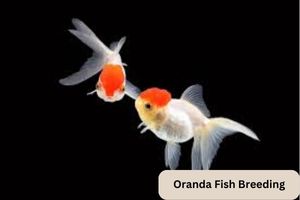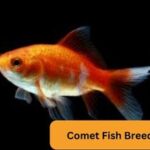Oranda Fish Breeding
A fancy goldfish known as an oranda is distinguished by its huge, bubble-like head growth. This growth on the head is known as a wen, and it can be red, white, black, or yellow. Oranda fish are distinguished by their long, flowing fins and their thick, rounded bodies.
Although oranda fish are native to China, they were developed in Japan in the late 1700s. They are currently among the most well-liked varieties of goldfish worldwide, and they are frequently kept in ponds or aquariums.
Oranda fish require a larger tank than some other varieties of goldfish, but they are still reasonably simple to care for. Additionally, they require water that is at least 65 degrees Fahrenheit and has a pH of 7.0 to 7.5. Oranda fish are omnivorous and consume flakes, pellets, and live food, among other things.
Oranda fish can live for a very long time and get pretty big. Oranda fish can grow to be over 12 inches long and some have been known to live for over 20 years.
There are a few things to consider if you’re considering getting an oranda fish. You will first require a sizable tank or pond. The pH and water temperature must both be maintained consistently for them. Third, you must give them healthy food.
Oranda fish can be a lovely addition to your house if kept in good condition. They are resilient fish that are comparatively simple to care for and can give you many years of pleasure.
Here are some more recommendations for taking care of oranda fish:
- Give them a tank or pond with a minimum capacity of 30 gallons.
- Fahrenheit 65 to 75 should be the target range for the water’s temperature.
- To keep the water clear and well-oxygenated, use a filter.
- To provide them places to hide, add some plants to the tank or pond.
- Give them a high-quality diet made especially for goldfish.
- Keep a watchful eye out for any disease symptoms.
- Oranda fish may live a long and healthy life with the right care. They are a lovely and beneficial addition to any aquarium at home.
Some of the most well-liked oranda fish species are listed below:
- Oranda with a Red Cap: This kind of oranda has a White body and a Red Headgrowth.
- Oranda Black Moor: This variety of oranda has a white body and a black headgrowth.
- The Azuma Nishiki Oranda has a red headgrowth and a nacreous-colored body.
- The oranda known as a “pompom” has a big, fluffy headgrowth.
- Oranda with Celestial Eyes: This kind of oranda has eyes on the top of its head.
Oranda fish are a colorful and varied species of fish. They are certain to bring a touch of elegance to any aquarium thanks to their massive head growths and vibrant bodies.

Oranda fish, also known as the Red Cap or the Fancy Goldfish, is one of the most popular ornamental fish breeds kept by hobbyists around the world. With their distinctive hood-like growth on their heads and vibrant colors, Orandas are a sight to behold.
Breeding these beautiful fish can be a rewarding experience for fishkeepers, but it requires careful attention and understanding of their unique characteristics. In this guide, we will explore the key aspects of Oranda fish breeding.
- Selecting Healthy Breeding Stock: The first step in successful breeding is to choose healthy adult Oranda fish as breeding stock. Look for fish that are active, have no physical deformities, and display vibrant colors. Males and females can be distinguished by their body shape and finnage. Males typically have slender bodies with pointed pectoral fins, while females have rounder bodies and shorter, rounded pectoral fins.
- Setting up the Breeding Tank: A separate breeding tank should be set up with a sponge filter to maintain water quality without harming delicate fry. The water temperature should be kept between 70-76°F (21-24°C), and a pH level of 7.0-7.4 is ideal. Live plants, such as Java moss, provide hiding places for the fry and encourage spawning behavior.
- Conditioning the Breeders: Before introducing the fish to the breeding tank, it is essential to condition them. Feed them a varied diet of high-quality pellets, frozen or live foods to ensure they are in peak reproductive condition. Conditioning may take a few weeks.
- Introducing the Breeding Pair: Place the male and female Orandas in the breeding tank together. The male may begin to chase the female, and if she is receptive, she will lead him to a suitable spawning site.
- The Spawning Process: Orandas are egg-layers, and the female will lay eggs while the male fertilizes them. The sticky eggs attach to surfaces near the spawning site. After spawning, the adults should be removed from the tank to prevent them from eating the eggs.
- Rearing the Fry: The eggs will hatch in about 4-7 days, depending on the water temperature. Once the fry are free-swimming, they must be fed small, nutritious foods such as baby brine shrimp or specialized fry food. Be diligent in maintaining water quality as fry are sensitive to changes.
- Growth and Development: Oranda fry grows rapidly, and their distinctive hoods may start to develop within a few weeks. As they grow, monitor their health and separate any deformed or stunted individuals to prevent potential health issues.
- Gradual Culling and Selection: As the fry grows, they need more space. Gradually thin out their numbers by culling weaker or undesirable individuals. This process helps ensure healthier, stronger fish in the long run.
- Reaching Maturity: Orandas typically reach sexual maturity at around one year of age. By this time, their colors and hood growth will become more pronounced, and they will be ready for potential breeding.
A fancy goldfish known as an oranda is distinguished by its huge, bubble-like head growth.


